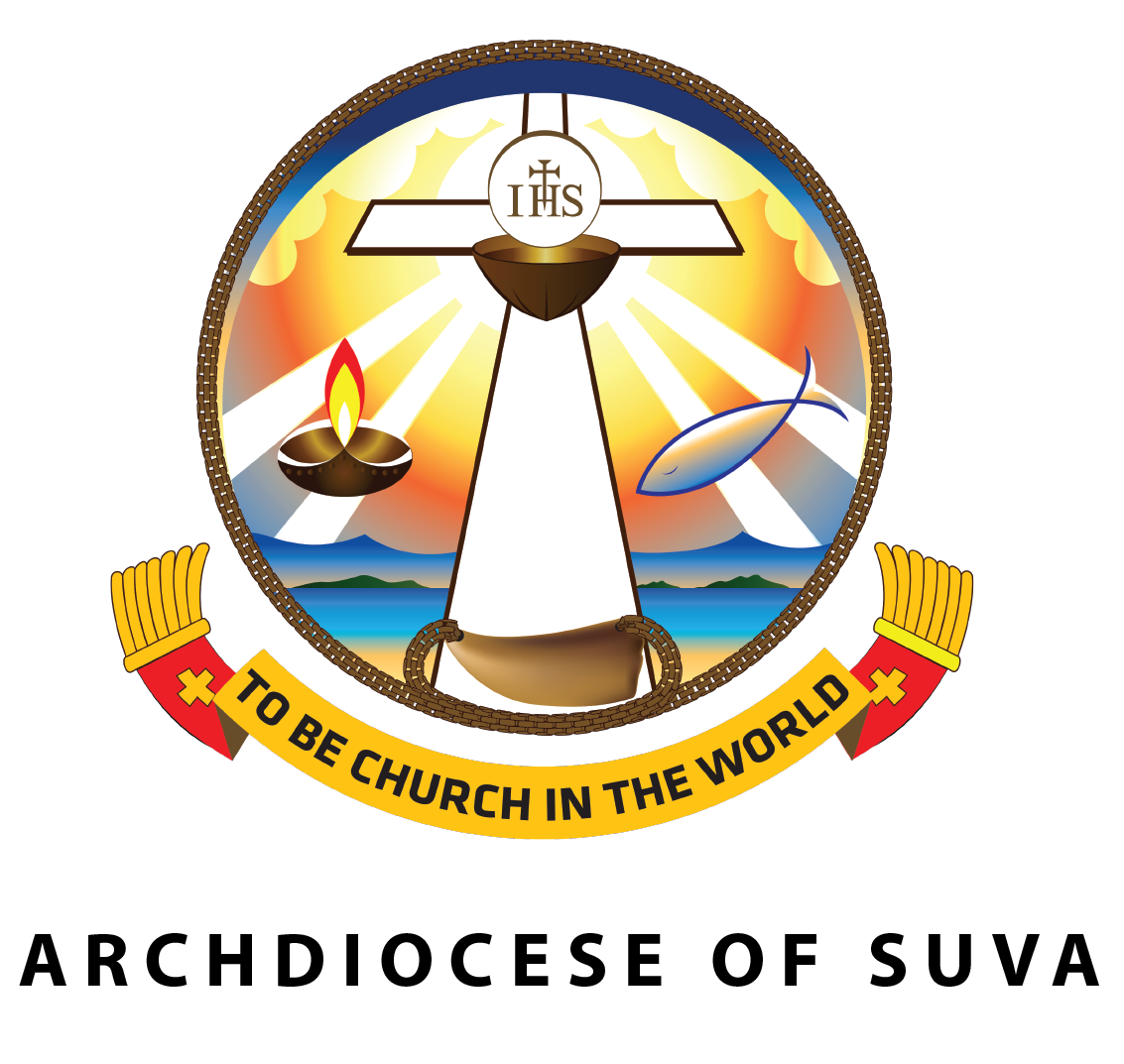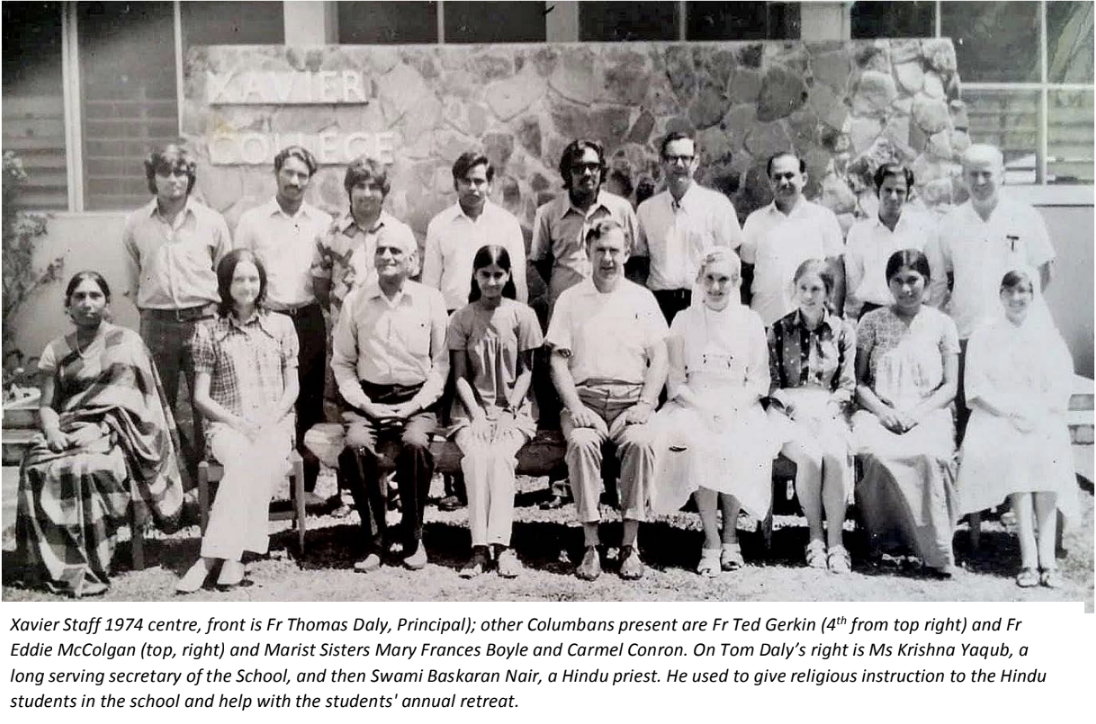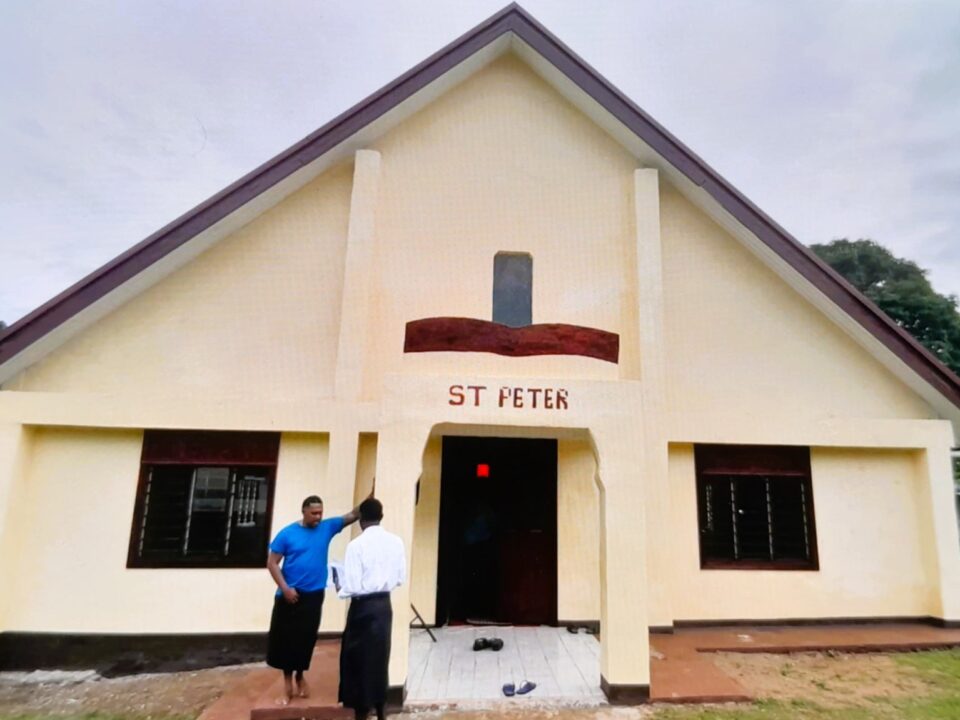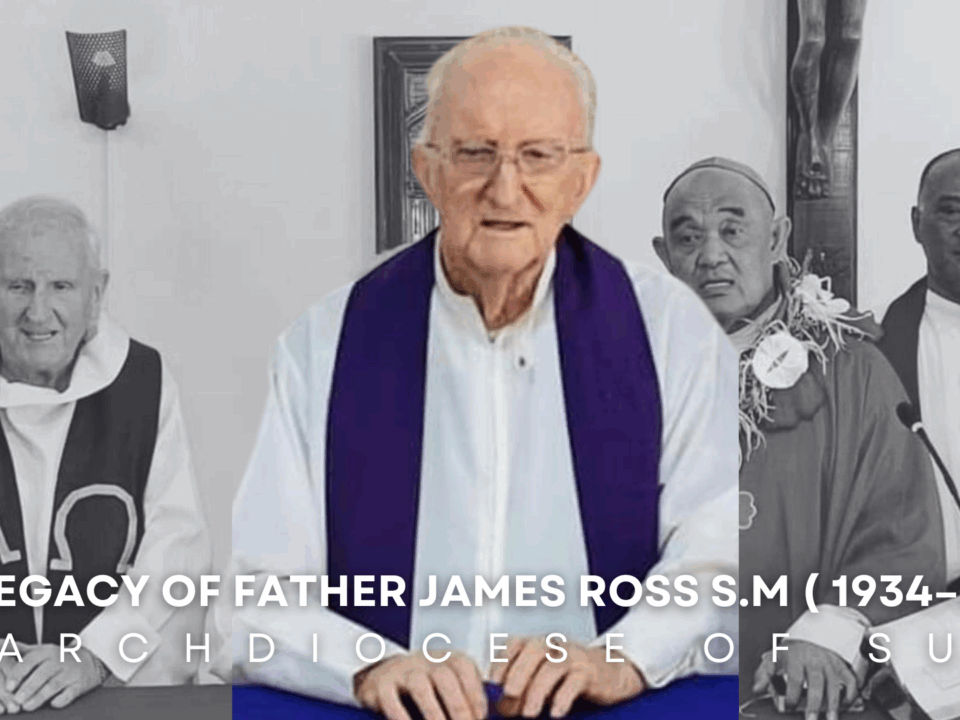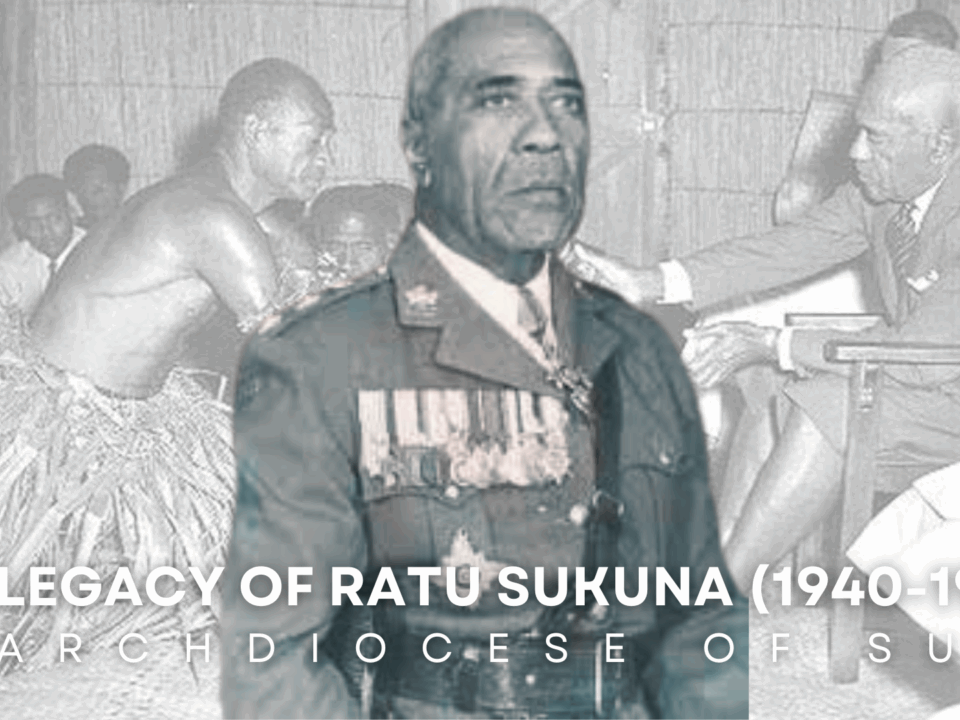The Columbans and Xavier College by Fr Eddie McColgan
When Xavier College opened its doors as a secondary school in 1953 it was a unique initiative in the Society of St. Columban. Other schools had been set up by Columbans and managed by them, but Xavier alone was a school set up by the Columbans and also staffed by the Columbans.
On February 12, 1953 the first classes began at 8.00 o’clock in Xavier. The principal of the new school was Fr Michael Cryan and his assistant teachers were Father Gerry Hurley and Fr Kevin Fleming.
But let us go back, Xavier, the name it was known by from the beginning, is situated in Namosau about two miles from Ba Town. The land on which it is built became the property of the Ragg Family in 1931 and remained their home residence until the late 1940’s. Sometime around the mid 1940’s Sir Hugh Ragg, the head at that time of an old Catholic Family (who had set up the first four hotels in Fiji) donated the property to the Catholic Church. It was what is known as Crown Land and the lease rent was two shillings a year (now equivalent to $0.40) and the lease was for 99 years from 1931. Sir Hugh’s intention was that the property would be used for a secondary school to provide education for the Part-Europeans, children of the families who worked in the C.S.R. (Colonial Sugar Refinery) mill not far from the site.
However, Bishop Foley (later to become the first Archbishop of Suva) had neither the funds nor the staff to build and run the secondary school at the time. So in 1948 using buildings left behind by the Ragg Family he set up a minor seminary on the Namosau property. The seminary at Namosau was short lived, and by 1952 it had moved to Cawaci on Ovalau. It became a secondary school in 1952 run by the Marist Fathers and embodying the minor seminary. It was in the newly opened St. John’s Xavier Staff 1974 centre, front is Fr Thomas Daly, Principal); other Columbans present are Fr Ted Gerkin (4th from top right) and Fr Eddie McColgan (top, right) and Marist Sisters Mary Frances Boyle and Carmel Conron. On Tom Daly’s right is Ms Krishna Yaqub, a long serving secretary of the School, and then Swami Baskaran Nair, a Hindu priest. He used to give religious instruction to the Hindu students in the school and help with the students’ annual retreat. Cawaci under Fathers Johnnie Clarkin and Tom Foley (Marist Fathers) that the first staff of Xavier was trained although neither the Marists nor the Columbans were aware of Bishop Foley’s plans at the time. Ostensibly Mick Cryan, Gerry Hurley, Arthur Tierney were studying and learning the Fijian language in Ovalau.
Somewhere towards the end of 1952 Bishop Foley made a request to Fr Denis Fitzpatrick for the Columbans to set up a secondary school on the Namosau property and when Dinny agreed, three of the priests who had been in Cawaci were appointed to the new, still non-existent, secondary school. In asking the Columbans to set up a secondary school, Bishop Foley did not mention the original request of Sir Hugh Ragg regarding the purpose of the new school. The instruction he gave to Michael Cryan was that the school was to be mainly to educate Indian children.
He emphasized that it was not to be a centre of proselytism but that it should be a means of contact with the Indian people so that they would come to know and to be in contact with Christianity- it was to be a presence and a witness in a non-Christian area and he expressed the importance he attached to the staff visiting Indian homes.
Bishop Foley had no money but he handed over the property on which were two buildings remaining from the Ragg residence period, together with three small but comfortable cement dwelling houses that Fr Clarkin had built for 300 pound each, in anticipation of the Seminary. There were also two classrooms which had been built for the same purpose. Some of these buildings are still in existence but some have been removed in recent years to make way for magnificent new classrooms and a modern residential home.
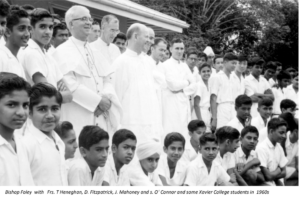
The first entrance examination to the new school was held by Frs. Michael Cryan and Tom Foley on the feast of St. Francis Xavier 1952. There were over seventy applicants as there were no other secondary schools in the Ba area at that time. Of these Frs. Cryan and Foley judged that twenty- five were capable of secondary education and these were accepted. The first students entered the Bishop Foley with Frs. T Heneghan, D. Fitzpatrick, J. Mahoney and s. O’ Connor and some Xavier College students in 1960s new secondary school at 8.00 o’clock on the morning of February 12, 1953 and were introduced to secondary education on a lesson of Latin for forty-five minutes followed by a grass-cutting break of one hour to be followed by a class in Algebra and followed again by more grass-cutting.
The Columbans and the new staff made a great step in faith on that morning. They had the buildings and the property that Bishop Foley had handed over-but no money. The fees for the first year were £15, £10 of which was designated for the maintenance and upkeep of the priests and five for the school. Later a fee of 15 shillings was added for purchase and maintenance of science equipment.
Early in the first year of Xavier’s existence Fr Cryan decided to make use of a promise that a Muslim teacher at St. Teresa’s School, run by the Marist Sisters in Ba, had made to Bishop Foley. During a visit to St. Teresa’s , probably on the occasion of Confirmation, the bishop was present at a fund raising bazar for the school. He saw the wonderful work that Mohammed did in raising funds for St. Teresa’s and asked him if he would assist in raising funds for a new secondary school in the Ba area. Mohammed promised that if a new school was set up by the Catholic Church he would assist in raising funds for it.
After much discussion with his staff and other Columbans during the first school year, Fr Cryan decided to take him up on his promise. It was decided that since there was not yet a school committee or a parent teachers association the funds would have to be raised by the personal contact.
This was not a very felicitous introduction to the local Indian community. Requesting money is never a good introduction but to request money(by people largely unknown to anyone) for a school that had not yet proved itself, was not going to be pleasant task.
But if the young Irish priests were unknown Mohammed Ali was one of those people that we sometimes meet who was known to everyone and had perhaps on numerous occasions pulled a few stings to have a Muslim or a Hindu or Sikh admitted to St. Teresa’s which at this time was by far the most important school in Ba. And Mick Cryan decided to hold him to his promise to Bishop Foley. He persuaded Mohammed to accompany him as he went around collecting funds for the new school. He was a godsend. Not only did Mohammed know Hindi and Urdu and English and Fijian he also knew and understood the people of Ba.
A target of £4,000 was set. £3,000 was to build the two new classrooms that would very soon be needed and £1,000 to provide science equipment and basic library.
Mohammed introduced Fr Cryan at each home. He then gave the family a long talk about the importance of education and how these young men had come all the way from Ireland to help their children get on in life. After much humming and hawing the family would offer to donate five shillings to such a worthy cause, whereat Mohammed would laugh and say, “But we are trying to raise £4,000.” Eventually he would persuade most donors to give or promise £5 and then as he wrote the receipt, would hesitate and say, “Five guineas”. And frequently the poor man would agree. Much of the money was in pledges and had to be collected by Fr Cryan and Master Mohammed at times of payment for the sugar cane. As Fr Cryan said “Standing there I knew for the first time the feeling of being a beggar. But both of us believed in what we were doing”. The collection was a success and the £4,000 target was reached.
Toward the end of 1954 two new classrooms were built and the nucleus of a science laboratory was set up in what had once been the Ragg family ‘Ball room’ where at least two members of the family had celebrated their marriages. These were to be Xavier College’s buildings for several years to come.
But in the year 1956 or perhaps ’57 Xavier finally became recognized by the government and became a ‘grant aided’ school. For the first time the staff could breathe freely. This meant that it became eligible for building grants and that the staff would eventually be paid a salary by the government. This was not only a blessing for Xavier but also for the whole Columban Community in Fiji. Many Columbans were in poor parishes, some starting off new parishes, and Bishop Foley could no longer pay the £100 per year that he had promised in the original contact for each Columban. He had no money. At the time too Fiji had no official status in the Society. Fr Dennehy who had taken on the Fiji Mission died in December 1951 and his successor was not at all enthusiastic about the new Mission. There was no money forthcoming from Society headquarters for Fiji support.
And so the fructus laboris of the Xavier College Staff helped in the support of other Columbans in Fiji. This situation carried on until the Fiji Mission became a region at the 1962 chapter.
In the meantime, much of the staff had changed. Fr Norb Feld, an American, joined the staff in 1955 to teach Science. Fr Jimmy Gavigan replaced Fr Gerry Hurley in 1956. In the same year Fr Thomas Henaghan, also an American, joined the staff. In February of 1958 Fr Eddie McColgan joined the staff and in February of the following year Fr John Mahoney replace Fr Norb Feld. In that same year Fr Feld took over as principal from Fr Cryan who had gone on his vacation. His health has suffered from all the stress and tension of setting up Xavier and raising funds.
However, it was several more years before he left Fiji to work for Columban Mission in Australia. Fr Cryan’s name is remembered by all who knew him with great awe and respect.
Fr Henaghan succeeded Fr Feld as principal and under his guidance Xavier took solid root. He was a quiet man and had the simple but beautiful chapel at Xavier built during his term as Principal. He also built the Physics & Chemistry halls and expanded and catalogued the library. Father came to Fiji after he had taught for many years in Silver Creek. He had a wonderful sense of dry humour and could keep a room full of priests amused for a full night and never repeat himself. It was during his term as Principal that Xavier became the main gathering place for Columbans. St. Patrick’s Day and St. Columban’s Day were celebrated there. The annual retreats and meetings were also held there. Fr Heneghan was not a young man when he came to Fiji and found the tropical heat too much. He was reassigned to Silver Creek in 1962.
It was in 1956 that the first boarders came to Xavier. They were three, Abbie Dyer, Kumrisan and another Indian boy from Lautoka whose name I forget. They lived in what Fr Henaghan had aptly christened “the train station”. It was a three-roomed block with toilet and shower and verandah that had been built during the Ragg family’s time to accommodate the friends and visitors of the family who were staying overnight.
Eddie McColgan who followed Tom Henaghan as principal did not know that Bishop Foley had verbally indicated that he did not want boarders. Xavier was to be a local school for Indians mainly and boarders should be sent to Cawaci which was specifically a Catholic boarding school. So Xavier accepted boarders on two conditions:
- that they passed the secondary school entrance examination which by now had become a public standard examination and,
- that they were Catholic.
During Fr Eddie McColgan’s time as Principal a new building containing dining rooms for the priests and the boarders and a toilet was built at a cost of $25,000.
During Fr Eddie’s time too a new class-room block was built to accommodate Form VI which was started about 1966. The staff at this time consisted of Frs. Dick Keelan, Pat O’Sullivan, Colum McGovern, John Mahoney, Arthur Tierney and Eddie McColgan. The priest staff at this time reached its peak and we hired our first lay teacher, an Indian man called Ram Sami.
A new block of classrooms was built in 1967 and, in acknowledgement of the great contribution made to Xavier by the Ragg family who originally gave the land on which the college was built, the new classroom block was named the “Ragg Building”. Lady Ragg, the wife of Sir Hugh, was invited to open the new building. She graciously accepted and made quite a generous donation towards its cost.
Fr Colum McGovern became principal in 1969 and the school rapidly expanded. A dormitory was built and a beautiful big administration block were built. The number of students had now grown to over 300 from the original 25. Over the years the reputation of Xavier had grown with its physical growth.
The results obtained in the public examinations were excellent in all grades, the soccer team had gained fame and glory in being champions of all Fiji secondary schools in four of six successive years around 1970 and, for the first time, the students were considered a threat in the annual athletics.
There was no girls’ secondary school nearer than Suva at that time and Xavier started taking girl students in1970 or 71. In the years following, girls soon became almost half of the school population.
The first lay teacher was employed in February 1968 and in 1971 the first lady teachers joined the staff. The first of several Marist Sisters joined the staff in 1971 also.
When Fr Thomas (Tom) Daly became principal after Colum McGovern he took over at a very critical time in the history of Xavier.
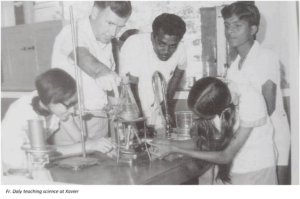
The presence of priest on the staff was drastically reduced as over a period of a few years, four priests who had been part of Xavier staff left the active ministry. Their departure was a big loss to both staff and students. The number of priest-teachers was reduces to two- Tom Daly and Dick Keelan. In 1968 Eddie McColgan had gone on leave and did not return to Xavier. However, in1972 he volunteered to assist Tom and Dick. In 1973 Fr Tom Daly went on leave and Fr Otto Imhote agreed to act as principal while he was gone. I’m sure it was a difficult assignment for him as he was there at a time when the staff had become very divided and a litigation case came up between two of the staff members. Things slowly returned to normal among the staff, which had now grown to about fourteen (seventeen lay teachers, one sister and two priests), when the two litigants transferred themselves to new schools.
From the middle of the 1970’s there were only two priests on the staff of Xavier and it became too difficult to maintain the boarding. As well, several other Catholic schools, either Junior Secondary or full secondary had started up in Viti Levu so there were more opportunities for Catholic boys to get a local Catholic education and there was less demand for boarding. So in the late 1970’s boarding closed down in Xavier.
It had been a very worthwhile experiment however, and from among those who had boarded at Xavier seven very fine young priests were ordained while one who taught for many years in the primary schools of Fiji after graduating from Xavier and Corpus Christi teachers College is now completing his studies in the United States, and hopes shortly to be ordained as a Jesuit priest.
When Fr Daly became principal in 1972 Xavier really blossomed out in all directions. Tom was a very simple man, holy and respected by all and went quietly about his duties. Under him Xavier expanded downwards as well as upwards and outwards. Along with Fr John Doyle, who was the parish priest of Ba at the time, he introduced Form 1 and Form II making Xavier now a high school stretching from Form 1 and Form VII. Form VII was added in his time too. And it also became a two streamed school the whole way through.
But while Tom supervised all these works and additions he was a firm believer in the motto, “A healthy mind in a healthy body”. He was a keen sportsman himself and during his time coached the Xavier team to their first medals in what was then known as the ‘All Fiji Athletics Competition’ in which every school in Fiji competed.
But his was not a one-track mind (pardon the pun). He also introduced American basketball, tennis, softball and volleyball. Along with all these sports soccer was still the most competitive game at Xavier. Rugby never really caught on, probably because the large proportion of the student body
was made up of Indians and girls.
Fr Daly made such an impression on the Education Department that he was asked to transfer as principal to Namosi Secondary School to help in its development.
By now the numbers of Columbans in Fiji had dropped drastically and they were desperately trying to find some Community to take over their works at Xavier.
When Fr Dan Ahern became principal after Tom Daly, he was fairly certain that he would be the last Columban Principal. And so he was. But just because he realized he would most probably be the last Columban Principal in Xavier did not discourage Dan from throwing his whole energy into continuing its development.
During his time, with the help of the government, computer studies became another subject and the computer centre was established a very big step forward in 1984. During Dan’s time too basic agricultural science was introduced and a small sugar cane farm established.
But by now the writing was on the wall. A suitable community had been found willing to take over Xavier as a running concern – The Monfort Brothers of St. Gabriel.
At the end of 1987 a chapter in the history of the Columbans in Fiji ended. Xavier was handed over as a going concern to the capable hands of the Monfort Brothers of St. Gabriel by the last principal Fr Dan Ahern. At the time Dan was alone on the staff with Fr Vincent Batchelor as chaplain and teacher of religion. Fr Batchelor remains the only Columban on the Xavier Staff and is the last link there with the Columbans.
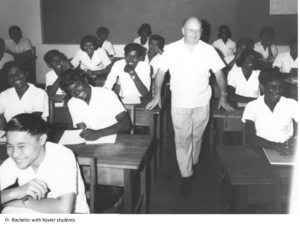
By 1987 the tiny school which opened its doors on the 12th February 1953 to a student body of 25 students had blossomed into one of the top secondary schools in Fiji. The students had grown from 25 to almost 700. The physical school of two small class-rooms had grown to a large plant of classrooms, science laboratories administration buildings, library, workshops and computer rooms.
The subjects taught increased from the very basic English, Maths, Latin, History and Basic Science to a curriculum that covered practically every subject both academic and technical taught in any school in Fiji. Since 1987 the Monfort Brothers have proved that they are more than worthy successors to carry on the Columban tradition. I always feel a little “pang” of pride when I read of the achievements of the school with which I was so long associated.
